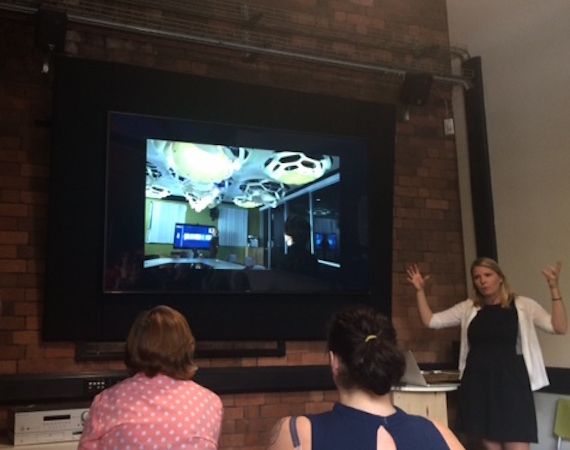Lunchtime talk write-up
Posted on Thu 6 Oct 2016
Ambient Storytelling for Personalised, Everyday, and Data-Driven Experiences
We met new Studio resident and UWE Professor of Media Arts Jen Stein, who shared her experiences of Ambient Storytelling.

This write up was penned by Aisha Sanyang-Meek, a content creator currently being mentored through Watershed's Rife programme. Born out of a partnership between Bristol Youth Links and Watershed, Rife is a magazine written for and by young people.
From sunny California to sunny Bristol, for this week’s lunch time talk we were joined by Jen Stein, a new UWE Professor, and prior lecturer at the University of Southern California’s School of Cinematic Arts, and co-director of the Mobile and Environmental Media Lab.
Jen discussed with us one of her recent projects, ‘Ambient Storytelling’, which explored the different forms of storytelling through technology mediums. Here are five things that I learned.
1. Shifting the expectations of linear narratives:
We have this idea that stories must proceed in linear forms, beginning, middle and end. Jen shared with us her experience of taking pictures on her iPhone whilst on holiday, which Google automatically generated into a chronological highlights reel of media content - marking out the beginning of her trip, when taking off on the plane to arriving at the final destination. This made me consider how linear form is usually the way we present our stories, but Jen suggested that this doesn’t always have to be the case, and playing with the placement of a narrative can be exciting!
2. Data is private!
May I also add, Jen was dismayed that Google had been able access her private photos and organise them into a slideshow without her permission! She went on to explain how data is so easily accessible these days, and how little security is needed to access different people’s private information from all over the world. And yet we use it everyday as means to document personal parts of our life. I found this really interesting, and got me thinking about how much we trust technology and rely on it even though it seemingly has a mind of its own.
3. Objects dreaming over the rainbow…
I discovered that Jen and her team ran a project called ‘StoryObjects’, the purpose being to create numerous hybrid physical/digital storytelling objects, made out of old recycled materials. The object’s would be able to dream images from they’re past and the people interacting with them would be able to receive these images on their phones via an app. An object that was used, that particularly stood out for me in the project was a table that was made from reclaimed timber from the sound stage in one of the film studios where ‘The Wizard of Oz’ was filmed in the 1930’s.
4. Humans are very connected to their cars…
Thinking about the different kinds of relationships people form with objects and how their experience of these objects might be augmented and personalized through data, Jen’s team conducted research into how people viewed their cars (as utility, as sport, as a companion). They found that many people anthropomorphized their cars through specific rituals like naming them and patting the dashboards as a “thank you”. They also wanted to explore what a story arc meant in regards to data-driven and personalized storytelling, specifically over potentially years of car ownership. They enlisted a user tester for a nine-month playtest, who was given a car and a software package that evolved with her driving.
5. Can the team work space become and actual team member too?
Through collaboration with Steelcase Workspace Futures, Jen’s team looked at how a team workspace could become an actual team member.
If a space gets to know the people who regularly inhabit it, can become a team member itself?
Jen’s team created lights, that in images looked like huge sea creatures stuck to the ceiling. They used low energy Bluetooth beacons to detect who was entering the room, which could trigger certain lighting and sound conditions for each person by accessing a database. They also used a processing sketch and a ‘Kinect’ sensor to drive the movement from the ceiling; it could transform the space for different kinds of work, i.e. creative brainstorming or more focused work.
It was definitely a fascinating and insightful way to spend a lunch hour: I got to discover how the interactions between humans, objects and data are constantly evolving. Everyone there seemed to be intrigued and inquisitive about the relationship society has with our technical devices.
Aisha is a writer, film maker and performer. You can see more of her work here.